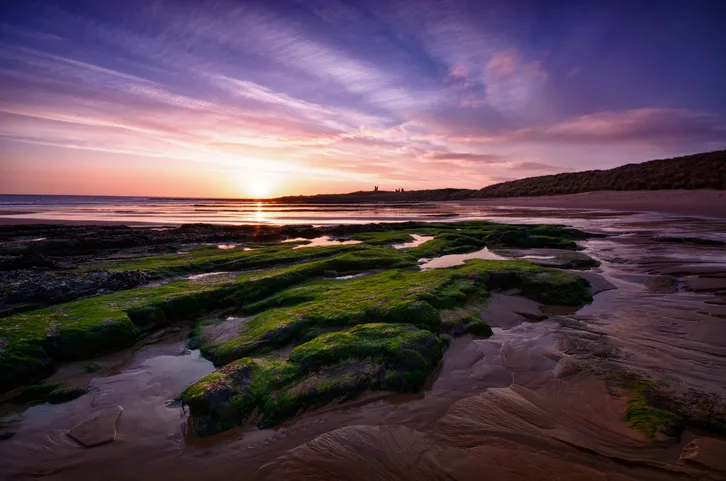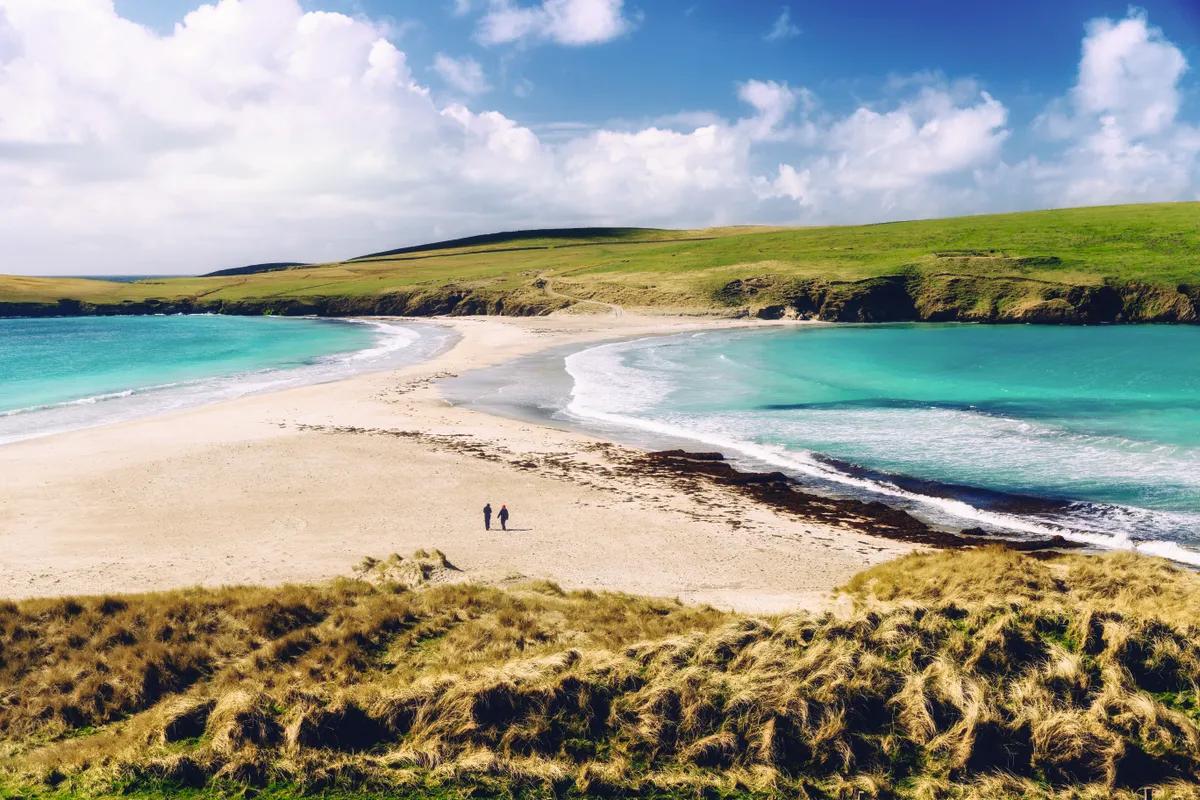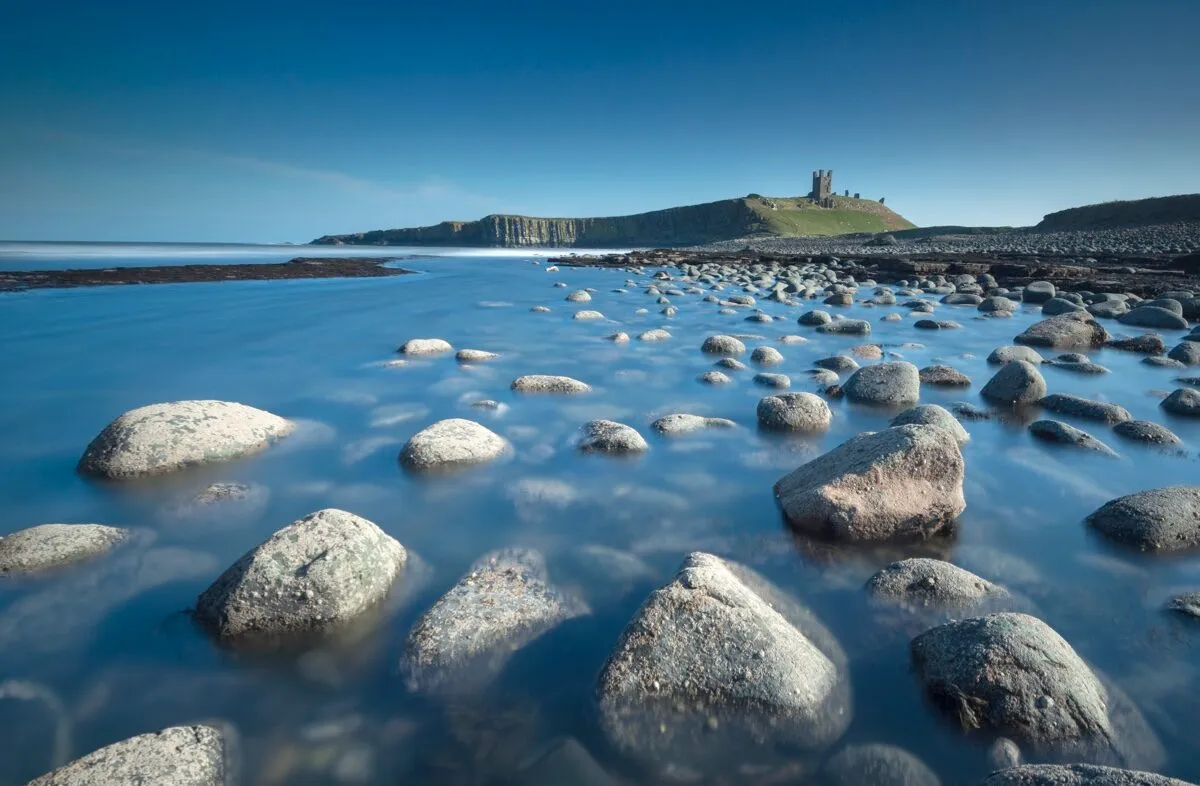The glorious, golden sands of Embleton Bay deservedly won BBC Countryfile Magazine’s Beach of the Year in 2017.
Yet despite the accolades, Northumberland’s beaches are rarely crowded. Even on a beautiful summer’s evening you will often have the place to yourself.
The dramatic sweep of this bay leads to the ruins of 14th-century Dunstanburgh Castle, perched on the dolerite rocks of the Great Whin Sill. While at the northern end of the beach, the white-washed cottages and historic pub of Low Newton-by-the-Sea, an 18th-century fishing hamlet, gather cosily around a village green.
Follow our circular plotted walking route along Embleton Bay in Northumberland.

Embleton Bay walk
10.8 miles | 5 hours | moderate
1. Castle Beacon
The beach is at its best on a sunny day at low tide. Start from the small car park in Low Newton-by-the-Sea and head steeply downhill to the village square. Resisting the lure of the adjacent Ship Inn, head down to the beach to begin an exhilarating stride along the sands.

From St Mary’s Haven, continue across the sands to pass a group of rocky outcrops known as Fish Carr, Out Carr and Jenny Bells Carr. A little out to sea is the Emblestone from which the bay takes its name. Oystercatchers will be probing the cracks and crevices of the hard, volcanic outcrops, or piping furiously from their perches. The route is never in doubt with Dunstanburgh Castle acting as your guiding beacon.

2. Sandy toes
You’ll have to remove your boots and socks to cross Embletonburn Mouth, though it’s a pleasure to do this section of the walk across the sands bare foot. If you don’t fancy wading across, you can turn a little inland to cross Embleton Burn on the footbridge before returning to the beach.
With the skeletal ruins of Dunstanburgh Castle drawing you in, leave the beach and climb the grassy path behind the shore’s dolerite rocks. These grey-black boulders give the impression of abandoned cannon balls on the beach.

3. Ruin with a view
Take some time to explore the dramatic castle, exposed to the elements on this wave-battered coastline. The ruins are now in the care of English Heritage. The great, twin-towered keep is a fabulous place from which to look back north across the bay and south to Craster, famous for its kippers, a local delicacy. Swallows zip in and out of the fortress walls, feeding up before heading south for the winter.
Retrace your steps to Low Newton-by-the-Sea or, better still, explore the dune system behind the beach. For the latter, take the grassy path past the site of an old quarry and on through the dunes to pass Dunstan Steads car park.

4. Coastal links
Continue on St Oswald’s Way and the Northumberland Coast Path through the marram grass-knitted dunes. The way re-crosses Embleton Burn on a wooden footbridge to pass the golf club and Embleton Links.
5. Pint at the ship
Take a moment to explore Newton Pool Nature Reserve, home to two bird hides. This is a great spot to look for coastal wading birds, including black-tailed godwits, sandpipers, lapwings and greenshanks.

Return to the path and turn left past Risemoor Cottage, a former fisherman’s pub. Continue beyond the boat yard and beside more cottages to the rear of the Ship Inn, before returning to the heart of Low Newton village.
Kick off your boots and enjoy lunch and a pint outside the historic Ship Inn. The pub serves a mouth-watering range of locally caught seafood, and the beer comes from its very own brewery.
From the village square, return to the road and then turn right to continue north
on St Oswald’s Way. This leads to a grassy course across Newton Point to return to the coast at Football Hole, a small sandy beach sandwiched between Snook Point and Newton Point.
6. Tiny terns
Drop down to Beadnell Bay just beyond Snook Point and stride out along the second gloriously sandy beach of the day. Again, route-finding is easy as you head across the beach to Beadnell Harbour. It’s time to remove your boots and socks again as you wade across Long Nanny Burn where it enters the beach.
The rare little tern can be found nesting here among the more common Arctic terns. This delightful little chattering seabird is the UK’s smallest tern and in August it will be leaving British shores to return to West Africa.
6. Cobles and kilns
Continue across the sands to enter Beadnell Harbour, home to three well-preserved lime kilns that date to the 18th century. Spend some time exploring this quaint little fishing port, looking out for cobles – a small fishing boat with Viking origins – bobbing about on the water.

7. Down in the dunes
Again, you have the choice of returning to Low Newton back across the sands or through the dune system at the back of the beach. St Oswald’s Way runs from the harbour through the caravan park to skirt Featherblow Hill. Pass through Tughall Mill Links and cross Long Nanny Burn on a bridge before passing the tern colony into Newton Links. Rejoin your outward route at Snook Point and return to Low Newton. Time for another pint at the Ship?
Embleton Bay map
Embleton Bay walking route and map


